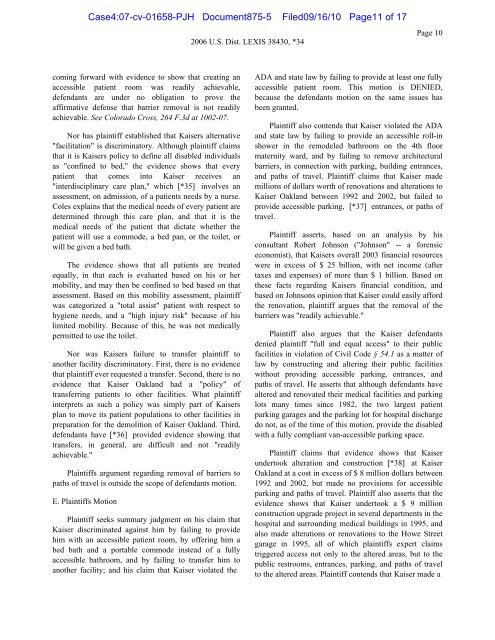exhibit 2 - SAP Lawsuit Portal
exhibit 2 - SAP Lawsuit Portal
exhibit 2 - SAP Lawsuit Portal
You also want an ePaper? Increase the reach of your titles
YUMPU automatically turns print PDFs into web optimized ePapers that Google loves.
coming forward with evidence to show that creating an<br />
accessible patient room was readily achievable,<br />
defendants are under no obligation to prove the<br />
affirmative defense that barrier removal is not readily<br />
achievable. See Colorado Cross, 264 F.3d at 1002-07.<br />
Nor has plaintiff established that Kaisers alternative<br />
"facilitation" is discriminatory. Although plaintiff claims<br />
that it is Kaisers policy to define all disabled individuals<br />
as "confined to bed," the evidence shows that every<br />
patient that comes into Kaiser receives an<br />
"interdisciplinary care plan," which [*35] involves an<br />
assessment, on admission, of a patients needs by a nurse.<br />
Coles explains that the medical needs of every patient are<br />
determined through this care plan, and that it is the<br />
medical needs of the patient that dictate whether the<br />
patient will use a commode, a bed pan, or the toilet, or<br />
will be given a bed bath.<br />
The evidence shows that all patients are treated<br />
equally, in that each is evaluated based on his or her<br />
mobility, and may then be confined to bed based on that<br />
assessment. Based on this mobility assessment, plaintiff<br />
was categorized a "total assist" patient with respect to<br />
hygiene needs, and a "high injury risk" because of his<br />
limited mobility. Because of this, he was not medically<br />
permitted to use the toilet.<br />
Nor was Kaisers failure to transfer plaintiff to<br />
another facility discriminatory. First, there is no evidence<br />
that plaintiff ever requested a transfer. Second, there is no<br />
evidence that Kaiser Oakland had a "policy" of<br />
transferring patients to other facilities. What plaintiff<br />
interprets as such a policy was simply part of Kaisers<br />
plan to move its patient populations to other facilities in<br />
preparation for the demolition of Kaiser Oakland. Third,<br />
defendants have [*36] provided evidence showing that<br />
transfers, in general, are difficult and not "readily<br />
achievable."<br />
Plaintiffs argument regarding removal of barriers to<br />
paths of travel is outside the scope of defendants motion.<br />
E. Plaintiffs Motion<br />
Case4:07-cv-01658-PJH Document875-5 Filed09/16/10 Page11 of 17<br />
Plaintiff seeks summary judgment on his claim that<br />
Kaiser discriminated against him by failing to provide<br />
him with an accessible patient room, by offering him a<br />
bed bath and a portable commode instead of a fully<br />
accessible bathroom, and by failing to transfer him to<br />
another facility; and his claim that Kaiser violated the<br />
2006 U.S. Dist. LEXIS 38430, *34<br />
Page 10<br />
ADA and state law by failing to provide at least one fully<br />
accessible patient room. This motion is DENIED,<br />
because the defendants motion on the same issues has<br />
been granted.<br />
Plaintiff also contends that Kaiser violated the ADA<br />
and state law by failing to provide an accessible roll-in<br />
shower in the remodeled bathroom on the 4th floor<br />
maternity ward, and by failing to remove architectural<br />
barriers, in connection with parking, building entrances,<br />
and paths of travel. Plaintiff claims that Kaiser made<br />
millions of dollars worth of renovations and alterations to<br />
Kaiser Oakland between 1992 and 2002, but failed to<br />
provide accessible parking, [*37] entrances, or paths of<br />
travel.<br />
Plaintiff asserts, based on an analysis by his<br />
consultant Robert Johnson ("Johnson" -- a forensic<br />
economist), that Kaisers overall 2003 financial resources<br />
were in excess of $ 25 billion, with net income (after<br />
taxes and expenses) of more than $ 1 billion. Based on<br />
these facts regarding Kaisers financial condition, and<br />
based on Johnsons opinion that Kaiser could easily afford<br />
the renovation, plaintiff argues that the removal of the<br />
barriers was "readily achievable."<br />
Plaintiff also argues that the Kaiser defendants<br />
denied plaintiff "full and equal access" to their public<br />
facilities in violation of Civil Code § 54.1 as a matter of<br />
law by constructing and altering their public facilities<br />
without providing accessible parking, entrances, and<br />
paths of travel. He asserts that although defendants have<br />
altered and renovated their medical facilities and parking<br />
lots many times since 1982, the two largest patient<br />
parking garages and the parking lot for hospital discharge<br />
do not, as of the time of this motion, provide the disabled<br />
with a fully compliant van-accessible parking space.<br />
Plaintiff claims that evidence shows that Kaiser<br />
undertook alteration and construction [*38] at Kaiser<br />
Oakland at a cost in excess of $ 8 million dollars between<br />
1992 and 2002, but made no provisions for accessible<br />
parking and paths of travel. Plaintiff also asserts that the<br />
evidence shows that Kaiser undertook a $ 9 million<br />
construction upgrade project in several departments in the<br />
hospital and surrounding medical buildings in 1995, and<br />
also made alterations or renovations to the Howe Street<br />
garage in 1995, all of which plaintiffs expert claims<br />
triggered access not only to the altered areas, but to the<br />
public restrooms, entrances, parking, and paths of travel<br />
to the altered areas. Plaintiff contends that Kaiser made a


